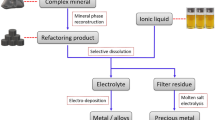Abstract
On the basis of an experimental study and thermodynamic calculation, the mechanisms of paragenesis and separation of silver, lead and zinc in the hydrothermal system have been studied. At acidic to nearly neutral pH, their chloride complexes are stable, and among them the chloride complexes of zinc are most stable. And the sulfide complexes are the dominant species at nearly neutral to alkaline pH, while the sulfide complexes of silver are most stable. With decreasing temperature, [Cl−],f o2 and increasing pH, the solubilities of silver, lead and zinc will decrease, leading to their deposition and separation. For sulfide complexes, the concentrations of reduced sulfur and pH are two important factors affecting their stabilities. Complexes of different forms and stabilities respond to the variation of conditions to different extents, which gave rise to the paragenesis and separation of silver, lead and zinc in the whole ore-forming process of dissolution, transport and deposition.
Similar content being viewed by others
References
Anderson G. M. (1973) The hydrothermal transport and deposition of galena and sphalerite near 100°C [J].Econ. Geol. 68, 480–492.
Anderson G. M. (1975) Precipitation of Mississippi Valley-Type ores [J].Econ. Geol. 70, 937–942.
Barnes H. L. (1997)Geochemistry of Hydrothermal Ore Deposits [M]. John Wiley and Sons, New York.
Barrett T. J. and Anderson G. M. (1982) The solubility of sphalerite and galena in NaCl brine [J].Econ. Geol. 77, 1923–1933.
Barrett T. J. and Anderson G. M. (1988) The solubility of sphalerite and galena in 1–5m NaCl solutions to 300°C [J].Geochim. Cosmochim. Acta. 52, 813–820.
Bourcier W. L. and Barnes H. L. (1987) Ore solution chemistry—VII. stabilities of chloride and bisulfide complexes of zinc to 350°C [J].Econ. Geol. 82, 1839–1863.
Cygan G. L., Hemley J. J., and Dangelo W. M. (1994) An experimental study of zinc chloride speciation from 300 to 600°C and 0.5 to 2.0 kbar in buffered hydrothermal solutions [J].Geochim. Cosmochim. Acta. 58, 4841–4855.
Fan Wenling, Wang Shengyuan, Tian Yifu et al. (2001) Complexation of Si in hydrothermal systems [J].Chinses Journal of Geochemistry. 20, 201–209.
Gammons C. H. and Barnes H. L. (1989) The solubility of Ag2S in near-neutral aqueous sulfide solutions at 25–300°C [J].Geochim. Cosmochim. Acta. 53, 279–290.
Gammons C. H. and Williams-Jones A. E. (1995) Hydrothermal geochemistry of electrum: Thermodynamic constraints [J].Econ Geol. 90, 420–432.
Helgeson H. C. (1969) Thermodynamics of hydrothermal systems at elevated temperatures and pressures [J].Am. J. Sci. 267, 729–804.
Hua Renmin (1993) Studies on the role and significance of fluid in the forming processes of ore deposits [J].Journal of Nanjing University (Earth Science).5, 352–360 (in Chinese with English abstract).
Johnson J. W. (1992) SUPCRT92: A software package for calculating the standard molar aqueous species and reactions from 1 to 5000 bar and 0 to 1000°C [J].Computer and Geoscience. 18, 899–947.
Nriagu J. O. (1971) Studies in the system PbS-NaCl-H2S-H2O: Stability of lead (II) thiocomplexes at 90°C [J].Chemical Geology. 8, 299–310.
Nriagu J. O. and Anderson G. M. (1971) Stability of the lead (II) chloride complexes at elevated temperatures [J].Chemical Geology. 7, 171–183.
Ruaya J. R. and Seward T. M. (1986) The stability of chlorozinc (II) complexes in hydrothermal solutions up to 350°C [J].Geochim. Cosmochim. Acta. 50, 651–661.
Seccombe P. K. and Barnes H. L. (1990) Experimental mobility of sulfides along hydrothermal gradients [J].Econ. Geol. 85, 1099–1113.
Seward T. M. (1976) The stability of chloride complexes of silver in hydrothermal solution up to 350°C [J].Geochim. Cosmochim. Acta. 40, 1329–1341.
Seward T. M. (1984) The formation of lead (II) chloride complexes to 300°C: A spectrophotometric study [J].Geochim. Cosmochim. Acta. 48, 121–134.
Shang Linbo, Fan Wenling, and Deng Hailin (2003) An experimental study of paragenesis and separation of silver, lead and zinc in hydrothermal solutions [J].Acta Mineralogical Sinica. 23, 31–36 (in Chinese with English abstract).
Tu Guangzhi et al. (1987)Geochemistry of Stratabound Deposits in China (Vols. 1and 2) [M]. pp. 1–69, 1–41. Science Press, Beijing (in Chinese).
Wesolowski D. J., Pascale Bénézeth, and Palmer D. A. (1998) ZnO solubility and Zn2+ complexation by chloride and sulfate in acidic solutions to 290°C within-situ pH measurement [J].Geochim. Cosmochim. Acta. 62, 971–984.
Wood S. A., Crerar D. A., and Borcsik M. R. (1987) Solubility of the assemblage pyrite-pyrrhotite-magnetite-sphalerite-galena-gold-stibnite-bismuthinite-argentite-molybdenite in H2O-NaCl-CO2 solutions from 200°C to 300°C [J].Econ. Geol. 82, 1864–1887.
Wu Daqing, Peng Jinlian, and Chen Guoxi (1996) Adsorption of silver ions sulfide minerals and its significance in mineralization [J].Geochimica. 25, 372–378 (in Chinese with English abstract).
Zhang Dehui (1997) Overview of research on the ore depositional mechanisms in ore-forming fluid [J].Geological Science and Technology Information.16, 53–58.
Author information
Authors and Affiliations
Additional information
Development and Planning Project of State Key Basic Research (G 1999042310).
Rights and permissions
About this article
Cite this article
Shang, L., Hu, R. & Fan, W. The mechanisms of paragenesis and separation of silver, lead and zinc in hydrothermal solutions. Chin. J. Geochem. 24, 82–89 (2005). https://doi.org/10.1007/BF02869692
Issue Date:
DOI: https://doi.org/10.1007/BF02869692




